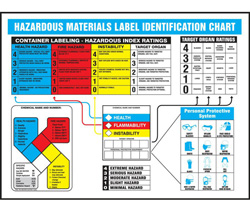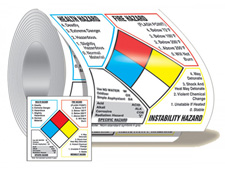| The Home page of ILPI's Safety Data Sheet (SDS) Resource, the leader in SDS information since 1995! | |
| The history and philosophy behind this resource. | |
| A curated collection of books and reference materials concerning Safety Data Sheets and closely related topics. | |
| Paste your plain text SDS into the SDS-Demystifier, and it will be converted into a hypertext-enriched document with links to detailed explanations of each key term. | |
| An extensive list of frequently asked questions about Safety Data Sheets including regulations, content, compliance, and more. | |
| A humorous take on Safety Data Sheet jargon. Fill in the blanks on our entry form to generate a personalized Unsafety Data Sheet to share with your coworkers. | |
| Since 1995, we've maintained this massive curated list of the best places to find Safety Data Sheets on the Internet. | |
| You are here! Way more than a glossary, this hypertext-enhanced resource covers hundreds of SDS-related terms and expert knowledge. Each entry includes both the SDS relevance and links to additional authoritative resources. | |
| Archived results of Safety Data Sheet related polls taken by some of our millions of site visitors | |
| The OSHA regulations behind SDS regulations, including the inspection guidelines and over 400 official interpretations letters under the Hazard Communication Standard | |
| Commercial suppliers of SDS authoring and management software as well as cloud compliance services. | |
| Commercial companies that will create SDS's for your specific needs as well as SDS translation companies. |

Safety signs, banners, and scoreboards? Get yours at Safety Emporium!
Definition
As defined by the 2012 version of OSHA Standard 29 CR 1910.1200 (the OSHA Haz-com standard, HCS 2012), a hazardous chemical is one which is a physical hazard or a health hazard.

Keep informed about workplace hazards with proper labeling techniques and safety posters available from Safety Emporium.
HCS 2012 defines a health hazard as:
"...a chemical which is classified as posing one of the following hazardous effects: acute toxicity (any route of exposure); skin corrosion or irritation; serious eye damage or eye irritation; respiratory or skin sensitization; germ cell mutagenicity; carcinogenicity; reproductive toxicity; specific target organ toxicity (single or repeated exposure); or aspiration hazard. The criteria for determining whether a chemical is classified as a health hazard are detailed in Appendix A to §1910.1200 -- Health Hazard Criteria.
HCS 2012 defines a physical hazard as:
"...a chemical that is classified as posing one of the following hazardous effects: explosive; flammable (gases, aerosols, liquids, or solids); oxidizer (liquid, solid or gas); self-reactive; pyrophoric (liquid or solid); self-heating; organic peroxide; corrosive to metal; gas under pressure; or in contact with water emits flammable gas. See Appendix B to §1910.1200 -- Physical Hazard Criteria.
This resource focuses on Safety Data Sheets, but there are plenty of non-chemical hazards that OSHA also addresses. One of the most important, and one that overlaps with HCS 2012, is 29 CFR 1910.147, The Control of Hazardous Energy (Lockout/Tagout) Standard. The LOTO standard addresses seven types of hazardous energy and specifies the safety measures that employers must take to comply:
- Mechanical - such as power transmission apparatus, counterbalances, springs, pressure, gravity etc.
- Pneumatic - pressurized gases.
- Hydraulic - pressurized liquid.
- Electrical.
- Chemical - includes flammable and combustible liquids; flammable gases. It also includes chemicals such as acids and bases that may thermally produce burn injury through high or low temperature.
- Nuclear - typically X-ray equipment and isotopes.
- Thermal - high or low temperature equipment/processes that could cause injury to employees.
The LOTO standard only considers danger present when energy may be released in quantities or at rates that could injure employees. In contrast, the HazCom Standard considers hazardous to be an intrinsic property of a material - e.g. if a material is hazardous, it is hazardous in any amount, no matter how small. See Hazard vs Risk, below.
Additional Info
Under paragraph (d)(1) of HCS 2012, "chemical manufacturers and importers shall evaluate chemicals produced in their workplaces or imported by them to classify the chemicals in accordance with this section. For each chemical, the chemical manufacturer or importer shall determine the hazard classes, and where appropriate, the category of each class that apply to the chemical being classified. Employers are not required to classify chemicals unless they choose not to rely on the classification performed by the chemical manufacturer or importer for the chemical to satisfy this requirement."
Paragraph (d)(3)(i) of HCS 2012 requires those evaluating chemicals to follow the procedures described in Appendix A and Appendix B of HCS 2012 to classify the hazards of the chemicals or mixtures thereof.
Hazard vs Risk

Communicate workplace hazards with handy labels from Safety Emporium.
A hazard is an inherent (built-in) property of a material. Risk is the extent to which that material can cause harm. You can reduce or remove risks associated with a hazardous material, but you can not remove the underlying hazard itself (unless you get rid of the hazardous material, of course). For example, gasoline is hazardous, but it does not have a significant risk provided that proper use and storage precautions have been taken. See the last three links under Further Reading below for more information and discussion on this very fine (but very important) point.
Treatment under the now-obsolete 1994 version of the Hazard Communication Standard
Under the now-obsolete 1994 version of the HCS, "health hazard" was defined as a "chemical for which there is statistically significant evidence based on at least one study conducted in accordance with established scientific principles that acute or chronic health effects may occur in exposed employees. The term "health hazard" includes chemicals which are carcinogens, toxic or highly toxic agents, reproductive toxins, irritants, corrosives, sensitizers, hepatotoxins, nephrotoxins, neurotoxins, agents which act on the hematopoietic system, and agents which damage the lungs, skin, eyes, or mucous membranes. Appendix A provides further definitions and explanations of the scope of health hazards covered by this section, and Appendix B describes the criteria to be used to determine whether or not a chemical is to be considered hazardous for purposes of this standard."
HCS 1994's definition of physical hazard also differed. It defined a physical hazard as a " chemical for which there is scientifically valid evidence that it is a combustible liquid, a compressed gas, explosive, flammable, an organic peroxide, an oxidizer, pyrophoric, unstable (reactive) or water-reactive."
Hazard determination under HCS 1994 (as opposed to the considerably more rigorous hazard classification under HCS 2012) relied on these two sources to establish a chemical as being hazardous (see paragraph (d)(3) of HCS 1994):
- 29 CFR part 1910, subpart Z, Toxic and Hazardous Substances, Occupational Safety and Health Administration (OSHA) or,
- "Threshold Limit Values for Chemical Substances and Physical Agents in the Work Environment," American Conference of Governmental Industrial Hygienists (ACGIH) (latest edition). The chemical manufacturer, importer, or employer is still responsible for evaluating the hazards associated with the chemicals in these source lists in accordance with the requirements of this standard.

When working around hazardous sources of energy, OSHA requires the use of lockout devices like these from Safety Emporium.
SDS Relevance
Safety Data Sheets provide the necessary information for you to understand and deal with the potential hazards associated with a particular substance. Read the sheet carefully before you use a hazardous material for the first time or any time you are unsure about the hazards or necessary precautions. The SDS can help you assess and reduce the risks (but not the underlying hazards; see above) associated with the materials in your workplace.
Remember: SDS's are only required for materials that are hazardous. Often times, manufacturers are asked for SDS's for products that do not meet this requirement - manufacturers are under no obligation to produce SDS's for non-hazardous materials. Both we and OSHA discourage the production of SDS's for non-hazardous materials (listen up, corporate attorneys).
Our SDS FAQ contains more information and a list of materials that may not require SDS's under the OSHA HazCom Standard.
Further Reading
- OSHA's Hazardous Chemicals in Labs Fact Sheet (270 K PDF download).
- OSHA's page on chemical hazards and toxic substances including recognition, evaluation, controls, standards and more.
- Small Business Safety and Health Handbook is a great starting place for employers to see what they need to comply with the HazCom and other OSHA standards.
- Risk and Hazard: How They Differ by CEFIC - the European Chemical Industry Council.
- Risk vs Hazard from the European Council for Plasticisers and Intermediates.
- Communicating Risks and Benefits: An Evidence-Based User's Guide at the US FDA.
- Basics of Informed Substitution & Alternatives Assessment at OSHA. Part of their compilation on Transitioning to Safer Chemicals: A Toolkit for Employers and Workers.
- Substitution of hazardous chemicals at OECD includes a 2021 report Guidance on Key Considerations for the Identification and Selection of Safer Chemical Alternatives.
See also: toxic, carcinogen.